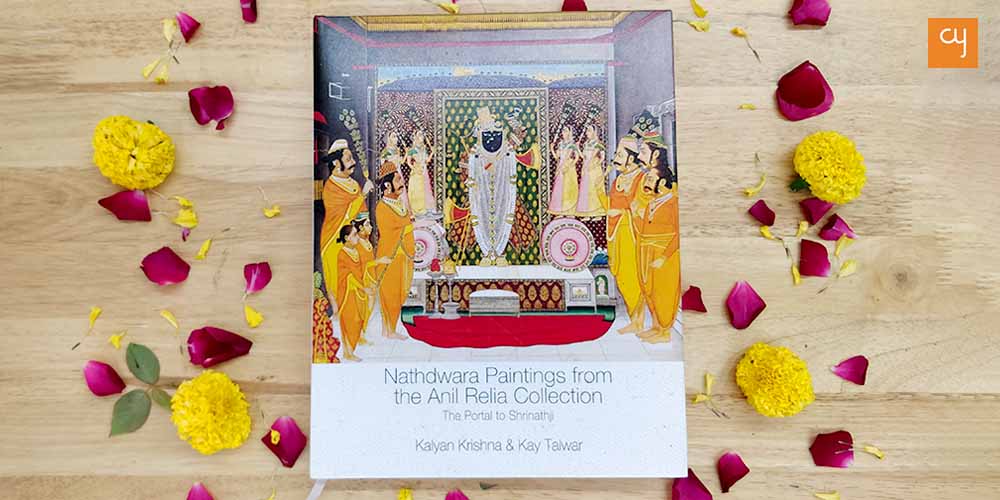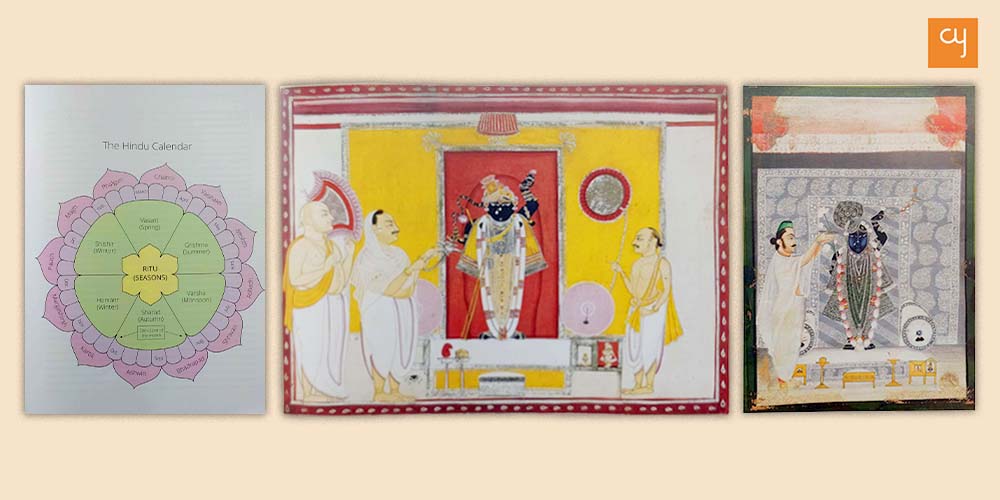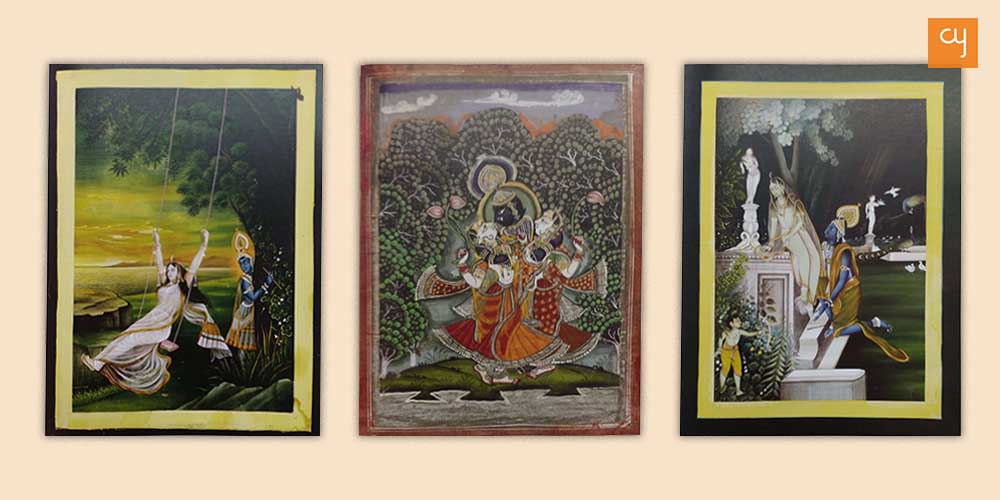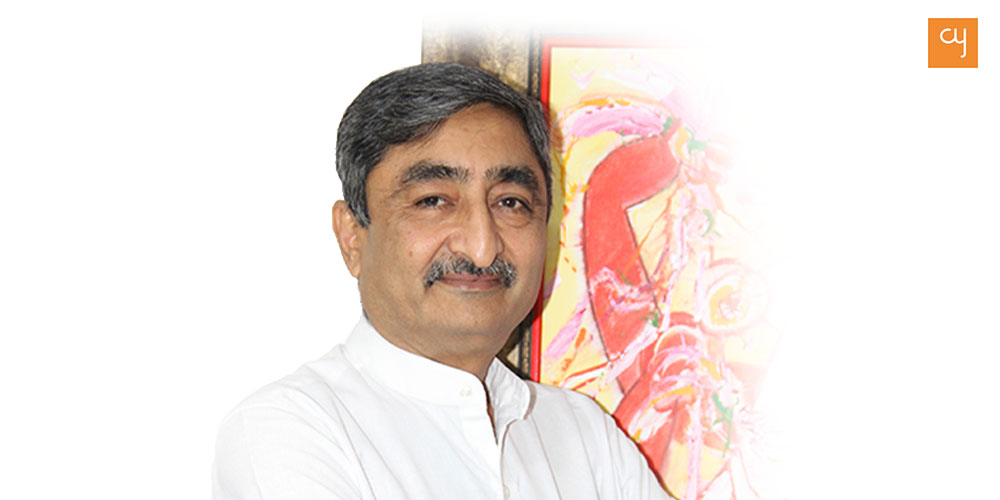
Toso preet tod, Krishna, kaun sang jodu-n – If I break the thread of love with you, Krishna, who else would I bond with! Meera’s gopi-bhav of complete surrender to Krishna is seen in all his devotees – ordinary ones, singers, poets, dancers and artists – irrespective of gender. He permeates the universe like irresistible fragrance for them. He is that aananda tattva, which if perceived, sought and attained, they find life fulfilled.
Among such artists are the creators of Nathdwara Paintings of Shrinathji, who is worshipped in the Pushtimarg of the Vaishnav sect of Hinduism. The paintings, on pichhvais hung on the walls of Shrinathji Temple (also known as Haveli), occasionally bought by connoisseurs, and in the paintings noticed behind the deity as the backdrop, are the outcome of the painters’ devotion to both the icon perceived divine and an intricate art created with significant lines and colours. Shrinathji is child Krishna (7) here, one of his countless forms worshippers adore giving a moorta svaroop to what they feel is present atra, tatra, sarvatra – here, there, everywhere. Nathdwara Paintings from Anil Relia Collection : The Portal to Shrinathji, edited by Sucharita Ghosh and elaborately yet with precision given text by the knowledgeable duo Kalyan Krishna and Kay Talwar to the luxuriant images from the Collection dripping joy and beauty beyond words, brings from the Aravalli Hills right into your drawing room (NIYOGI BOOKS, New Delhi, 2021).

The paintings are in the celebrated miniature painting genre rich in minute details. On finding the details following a patient close study, not only would art lovers partake of the delight they gave to the artists and devotees, but also to other viewers over the years, even if uninitiated in worship or art appreciation. The recurring motif in the book in coffee-book format with glazed paper is of Shrinathji, dressed in an attire appropriate to the context, presumably holding up the legendary Mount Goverdhan. The most fascinating among the themes finding expression in the paintings is the Shrinathji-centric celebration of the seasons and their festivals – Vasant, Grishma, Varsha, Sharad and Hemant/Shishir as also Vasant Panchami, Rathyatra, Dashahara and other festivals. Some of the other themes are Prakatya (Emergence) Darshan (Glimpse), Krishna’s Lilas (… Free Play) and Manoraths (Cherished Desires). The deity’s immaculate Shringar (adornment) for each occasion is different.
The book – I prefer the word book to catalogue – takes off with the Prakatya tale (spellings as in the book) of Shrinathji. Out of fear for the Mughal ruler Aurangzeb’s iconoclastic notoriety, as one of the tales goes, Krishna’s devotees fled Braj with him in a bullock cart, which got stuck in mud near village Sinhar in Mewar (Rajasthan). This was taken as indicative of Krishna’s desire for his destination and Nathdwara (Nath the Lord, dwara Portal : ‘The Portal to the Lord’) came into being. The sleepy nondescript village sprang to the eminence of a town attracting pilgrims and artists, art historians and art lovers from India and abroad besides people from the trading community.

Every page of the book gives a sense of indomitable exuberance. Shrinathji’s ornate images remain in the centre. As you open the book, you find a handsome Krishna, his skin black with shades of blue, eyes steady in contentment as a herdsman following keen-eyed expectant cows with his adorned left hand raised gently asking them not to hurry as a kindly gopi in front is approaching them with a plateful of fodder. He is holding a stick in his right hand – like a modern-day conductor’s baton! – to guide the cows’ harmonious movement. To give a taste of the freedom the cows enjoyed, the artist has one of them break the line and run to the offering, its hoops and curled up tail expressing its desire. Your attention remains riveted to the endearing herdsman with his adornments – the crown in gold colour, a dainty nathani, strings of white pearls and the white garland with relief in gold round his neck descending in curves nearly up to the ankles – in his flared skirt and the scarf blown on two sides by the breeze coming from across the green fields.
Difficult to select images from Krishna’s (read God’s) plenty. Here is one however with the author’s own observation and description – Shera manorath of Shrinathji (pp.136-7). ‘Shrinathji wearing a groom’s headdress (shera) … He is handsomely attired in a maroon gold brocade four-pointed coat (chakdar vaga), tight pajama (suthan) and a gold fringed red scarf (patka). … … A green thare vastra with gold tinsel printing (chhayala) covers the stele. The backdrop is a golden pichhavai painted on a deep red fabric. In a grove of resplendent gold trees pairs of slender gopis carrying peacock-feather whisks (morchhal) approach Shrinathji. At the very top is a depiction of Mount Govardhan…’
If the artistry, to the most minute details, displayed in a wide range of child Krishna’s images, later those of a grown-up Lord Krishna, testify to the creators’ remarkable artistic calibre, at its best with devotion, the analytical text accompanying them all through the precious 268-page hardbound book is a specimen of exceptional exactitude combined with warmth, in combination evoking moods, feelings and images, all after human counterparts. An excerpt from the description of the Shera manorath image is earlier given. What follows is a description of a sample of assorted images of the deity.

‘Every nuance of the season is reflected in the elements of the shringar (adornment). From wall hangings to clothes to jewels to music and poetry, the shringar is in tune with the sentiment (bhav) of the season.’ (p.22). ‘Vitthalnathji has covered his head in an expression of madhurya bhav appropriate for the rainy season of romance. His affection for Shrinathji is Radha’s love for her Krishna.’ (p.74).’ ‘In keeping with the changing seasons, the heady fragrance of flowers like jasmine (both mogra and chameli varieties, rose, lotus and plumera (champa) envelop the image and filter into the Dol Tivari (audience hall) intoxicating the devotees.’ (p.50). ‘The painting is divided into six panels. … Shrinatnji clad only in a loincloth (pardani) is being bathed (Mangla Snan). One gopi pours water over Shrinathji as two others offer more water and a towel (anga vastra).’ (p.152). ‘The style is not typical Nathdwara. The figure of Vrajnathji appears to have been copied from his provincial Mughal style portrait Kankroli ka Itihas. The figures on the right are less successful. Note that the artist’s attempt at perspective has resulted in a disconcerting pyramid of heads.’ (p.42)

Shrinathji paintings abound in burgeoning trees, lush plant leaves, blossoming orange Palash flowers, tiny lotus buds, white garlands, a profusion of creepers and floral designs, clouds, water and fish in movement, abir-gulal wafting in the air, pleasingly robust cows with plump udders and coloured horns, elegant elephants, horses and deer, legendary gop-gopis with a contented visage, singing and dancing devotees lost in their mood of dedication, monkeys and peacocks and ducks, musicians and kirtankars with familiar instruments of folk and classical music, artistic pots and earthen lamps.

A reference is needed to two paintings – Radha Swinging (p.221) and Krishna and Radha in a Garden. (p.223). Both inspired but one beautifully sensual, the other amorous. Talking of the theme of amour, there is a painting of Krishna embracing two gopis, ‘by clasping them around their necks’, sending them into raptures. (p.172). It has captured, as if with a camera, a rare sense of movement and the trio’s bhav. One notices in the Nahdwara paintings, incidentally, varied styles, some mature some others not exactly so. A few vary in quality as well.
The first flap of the book specially mentions Ghasiram Hardev Sharma as a prominent artist showcased, ‘who influenced a whole generation of twentieth-century artists.’ The other flap, at the end, introduces the two experts who have with exceptional verbal power analyzed the paintings. There is a welcome article on ‘Paper Painting Technique in Nathdwara’ by Kalyan Krishna preceding Appendices. Without the pleasing Design of the book, it must be noted, all the highlights discussed here would have gone unnoticed.

‘‘Nathdwara Paintings …’ is a precious book, rich in content and highly readable. It can have pride of place on art lovers’ shelf and at their coffee table. They would get to know more of an unassuming connoisseur Anil Relia’s passion for art collection and his insights into art works when normal times return and, if I am not letting out a secret, an exhibition of select Nathdwara paintings is held at the right place in Ahmedabad.
Image Source: Niyogi Books
Yatra Archives

 How Tulika Books is creating impact in children’s lives through picture books
Nandini Varma
How Tulika Books is creating impact in children’s lives through picture books
Nandini VarmaAug 21, 2019
A children’s book about a boy who feels like a girl. And about a child brought up by grandfathers. These are some of the stories published by Tulika Books, who have been making children’s picture books since 23 years. Little…
 Dalgona Coffee: A worldwide social media trend about home-made café experience
Harshil Shah
Dalgona Coffee: A worldwide social media trend about home-made café experience
Harshil ShahApr 2, 2020
While the lockdown has ignited various trends on social media, one that has received a major global following is #DalgonaCoffee. With thousands of posts on its name, here’s all you need to know about the Dalgona Coffee wave. I first…
 Leonardo, Michelangelo, Raphael and Donatello—Artists or Teenage Mutant Ninja Turtles characters?
Harshil Shah
Leonardo, Michelangelo, Raphael and Donatello—Artists or Teenage Mutant Ninja Turtles characters?
Harshil ShahNov 5, 2019
Did you ever wonder where the Teenage Mutant Ninja Turtles’ characters got their names from? Well, your search is complete. Here is a brief introduction of the artists from whom the creators of TMNT took inspiration. Teenage mutant ninja turtles,…
 The call of the mountains: orthopaedic Dr Yatin Desai’s advice on trekking
Himanshu Nainani
The call of the mountains: orthopaedic Dr Yatin Desai’s advice on trekking
Himanshu NainaniMay 24, 2019
In this piece 64 year old Dr Yatin Desai, shares with CY his inspiring story of how to scale towering mountains with utmost ease and how this life adventure activity can shape human character and health. Chances are high that…



